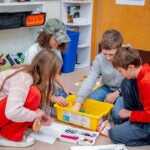Elementary Students Gearing Up for Robotics Competition
Summary : Early exposure to coding, design-thinking, and working as a team is essential to connecting students to careers of the future.

Elementary Students Gearing Up for Robotics Competition
FIRST LEGO League (FLL) Challenge is in full swing in Seattle Public Schools, with 23 teams participating from 20 schools across every region of the city. As part of the SPS K-12 STEM career pathway, this program engages students as researchers, programmers, and teammates with the support of dedicated volunteers and parents.
Students are gearing up for their first FLL event on Dec. 14-15, at Ballard High School. SPS school-based teams will compete alongside other Seattle-area teams and clubs in hopes of advancing to the second round in January. Students have been conducting research for this year’s “Submerged” theme, which they will present to a panel of judges on event day. Following this, teams will enter the robot competition, where their LEGO robots—programmed by the students—will attempt to clear a series of obstacles.
Elementary robotics is part of a larger push from the Career and Technical Education department to engage K-5 students in STEM learning, helping students to see themselves as STEM-capable from an early age. Students in FLL divide into groups of researchers, building/materials managers, project managers, and coders to create a robot capable of navigating an obstacle course.
Participating Elementary Schools
- Alki
- Arbor Heights
- Cascadia
- Concord
- Daniel Bagley
- Dearborn Park
- Decatur
- Greenwood
- John Hay
- John Muir
- Lafayette
- Lowell
- Loyal Heights (2 teams)
- West Seattle
- Whittier
Participating K-8s
- Louisa Boren
- Catharine Blaine (2 teams)
- Hazel Wolf
- Orca (2 teams)
- TOPS
Participating Middle Schools
- Aki Kurose
- Eckstein
- Madison
- Mercer
Corey Martin, a digital learning support instructor, is leading the elementary robotics effort. He said this is the first time the program has been district-coordinated with a vision for long-term sustainability. The digital learning team leveraged funds from a pre-pandemic Amazon grant to launch after-school robotics programs – particularly FIRST LEGO League.
“I spent part of the spring recruiting mentors and advisors and provided training in August to help build teacher-capacity around programming,” Martin said. “We’re also thankful to the parents and volunteers who are giving their time to these after-school programs, as well as principals who are eager to see this kind of learning in their schools.”
Martin is hopeful that in the next two years, every school will have at least one team, offering students across the district the chance to engage in this unique learning experience that is both competitive and cooperative.
“I’d also like to see ‘spring seasons’ emerge at schools so students can learn these skills outside of competition, so they can hit the ground running in the fall,” Martin said.
Martin’s ultimate goal is to incorporate robotics and physical computing into the school day.
“I want to see programming integrated into our math, science, and humanities curricula so every student gains hands-on programming experiences,” he said. “If we are going to prepare our students to live in this city and work in its tech-heavy and tech-adjacent industries, we need to expose them to this kind of learning and build the 21st-century skills they need to be successful.”

